#camille moran
Text
My name is Camille. I am a born transgendered woman. When I was a child I said that I was a girl but the world called me a "faggot." Under the sky of pain called psychiatry I was locked away for many years and had the requisite tortures: the terror of electroshock, my bones broken, my body drugged and raped. I was not raised as a gender but as a bug of a child to be smashed.
I am nobody's victim. My body belongs to me & so does my holy brain. I am the ghost of the untapped conscience of shrinks, a lurking justice, a part of the gathering truth that is rising with a common voice out of the wake of their evil blue fire.
Transsexuals are born into the book of labels. We may be genetic but we are not genetically defective sub-human creatures. By the very nature of our difference, the independence of our alien spirituality, and the passion of the power of our will, we are a threat to the ruling delusions of the mental death profession.
No one has our permission to debate the validity of our existence, to define our reality, to dismiss our pain, and to name us. We name ourselves.
If you could look into the collective genetic memory of your humanity you would find us in the rivers of your dreams, for we were always here, we were here when Earth was a green spirit. We were a natural occurrence in a singing world. In times of absolute horror and destruction I wish for you all the transformational creativity of an utterly beautiful madness, and I offer you the blessing of a holy human freak.
"Why A Transgendered Woman Calls for Psychiatry's Destruction" by Camille Moran, published in the Fall 1993 issue of Dendron.
#it speaks!#linked it in the previous post but i wanted to have the full text on my blog. screenshots of it have been posted on tumblr before ->#<- but i just wanted the text#paths outside this garden#hysterical studies#okay getting into the maintag & trigger shit now:#trans history#camille moran#antipsych#psychiatric survivors movement#mad pride#for triggers im not doing 'tw' im just doing the words lmk if that is not effective & lmk if i ought to trigger tag anything else. ->#transmisogyny#rape mention#child abuse#ableism#psychiatric abuse
81 notes
·
View notes
Text

The Feminine Child by Camille Moran, featured in the pages of the FTM International Newsletter #30 in 1995
Moran is an artist and poet, whose works often confront her experience as a survivor of institutionalization. She’s written foundational criticism of and worked as an activist against the psychiatric institution and it’s involvement with the lives and medicine of transgenderal people, including fighting for the removal of Gender Identity Disorder from the DSM.
#op#writing#poetry#camille moran#trans women#trans artists#trans writers#1990s#1995#ftm international#zines journals and publications#psych critical#anti psychiatry#rape mention cw#blood mention cw#transmisogyny cw#ask to tag
313 notes
·
View notes
Text
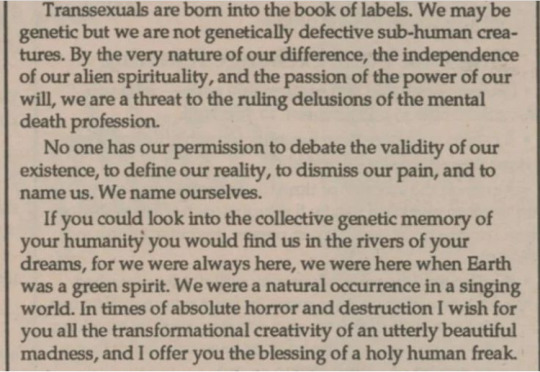
#from ‘why a transgendered woman calls for psychiatry’s destruction’ by camille moran#we were a natural occurrence in a singing world
7 notes
·
View notes
Text
I need you to understand why that camille moran piece is going around today. It is because yesterday I spent all afternoon in umass’s antipsych digital archives (which I think I’ve posted about quite a few times on here) instead of working on the thing I was supposed to work on. Why did I do that? Great question. The reason is that in our dsa chat, a member posted a nice reflection of their own experience with therapy and therapists routing them away from socialism or anticapitalist solutions. I wanted to direct this conversation toward a socialist interpretation of the role of therapy in our social relations--as readers of this blog know, this is an interpersonal and organizing interest of mine but also something that is somewhat underdeveloped in both marxist social reproduction and recent antipsych thinking. Which is to say that there is nothing I can really link to when someone says “source?” to me (public intellectuel, archival worker, and psych survivor). As you may also recall, one of my young comrades (who is also in the dsa chat) had a recent experience where someone organizing a union left the organizing committee (and decided not to sign a card) because their therapist told them organizing was bad for their mental health. This young queer comrade has a psych/therapy critical life experience and also has queer family members who have experienced psychiatric violence. But they felt like they could not yet openly share this anecdote in the chat, due to ongoing organizing. I also felt like I could not share my perspective in the chat, because dsa is extremely hostile to me speaking due to I’m a woman who doesn’t have a salary lol and also, once again as my readers may recall, a former leader of my chapter who is a therapist, nonprofit executive and social worker soft threatened to 5150 me after the george floyd protests because my input in a strategy chat was that we should not advocate for funding mental health services as alternatives to policing for various reasons chiefly among them that policing and police violence happens in mental health service providing spaces. Point being she’s in the chat and I feel like there’s a bit of a target on my back and I can’t talk about psych survivor stuff around her, or in dsa in general. So the young comrade and I were talking all afternoon and I was digging through old antipsych publications looking for maybe something I could link where psych survivors described unhelpful therapy experiences or made any kind of interpretation of the social relations of therapy. For various reasons most historical (which I could get into separately) I did not necessarily find anything quite like that, but I spent the afternoon sending antispych documents that Go Off to my young comrade as well as Sheena, including the camille moran piece in dendron. While I was doing so, the aforementioned therapist decided to route the therapy-critical conversation in her own Very Marxistly way: “As a licensed therapist.. if anyone has specific questions about therapy/therapists, what the letter means, etc please feel free to reach out.” So there you go!
58 notes
·
View notes
Text
The Kids Just Don't Understand January 15, 2024

Image: The Cupid Car Club, MP
listen on Mixcloud
Carole King - Pleasant Valley Sunday (Demo)
Sad Lovers & Giants - Alice (Isn't Playing)
Kraftwerk - Spacelab
Dancer - International Birdman
Bongi & Judy - Running Out
D.I. - Living in the USA
Hutton School Choir - Don't Drink and Drive
Armand Hammer - The Gods Must Be Crazy (feat. billy woods, E L U C I D & EL-P)
Thee Headcoats - The Leader of the Sect
The Shangri-Las - Heaven Only Knows
Blue Oil - Sardine City
Chumbawamba - So Long, So Long
Shirley Collins & Davy Graham - Pretty Saro
The Shna - Rafaela
Peach Kelli Pop - Do the Eggroll
The Rats - Gotta Get Away
Yanti Bersaudara - Badminton
Rondos - Tools
Flipper - Life
Pozi - Sea Song
Exploding White Mice - Dangerous
Holger Hiller - Chemische und physikalische Entdeckungen
Grrr - Scrape
Essential Logic - The Order Form
Violin Sect - Fit & Anxious
Pretty in Pink - Library Card
Camille Bénâtre - Sans terre et sans roi
Cupid Car Club, M.P. - Grape Juice Plus
Robert Moran, Richard Thain and Brian Nelson - Action Beat - Improvised Piece for Two Xylophones And Drums
Candy Machine - Shining
#radio#community radio#punk#music#playlist#post punk#wprb#transistor sister#electronica#folk music#krautrock#girl group
0 notes
Photo

“SHERBROOKE COURT CONVICTS 10 OF THEFT,” Montreal Star. November 6, 1931. Page 41.
----
Sentences of Six Months and Two Years Given
----
SHERBROOKE, Nov. 6. - (Star Special) - The investigations conducted by the provincial police force into the many robberies perpetrated in the Eastern Townships have met with much success and this morning in the Magistrate's Court convictions were obtained against 10 men on theft charges.
Judge J. H. Lemay sentenced Ralph Rossi of East Angus to two years in the Reform School for theft of hens and oats. Two confederates, Arthur Boutin and Blanche Boutin, also of East Angus, pleaded guilty to similar offences. Arthur Boutin was sentenced to six months on two accusations, the sentences to run concurrently while sentence on his sister will be passed later.
Henri and Tom Letourneau, Camille Caron, Richard Brousseau, Richard Moran, James Brothers and Alphonse Morache, of Montreal, all pleaded guilty to stealing from the A. P. Slack general store in Ayers Cliff. The Slack store was broken into on two occasions, nearly $700 being taken from the proprietor. Sentence will be passed next week.
#sherbrooke#east angus quebec#eastern townships#police court#theft#stolen chickens#chicken theft#chicken thieves#sentenced to the penitentiary#st vincent de paul penitentiary#sentenced to prison#sherbrooke jail#prison winter#great depression in canada#montreal#general store#crime and punishment in canada#history of crime and punishment in canada
0 notes
Text
JACOBIN FICTION CONVENTION MEETING 26: MADAME TUSSAUD: A NOVEL OF THE FRENCH REVOLUTION
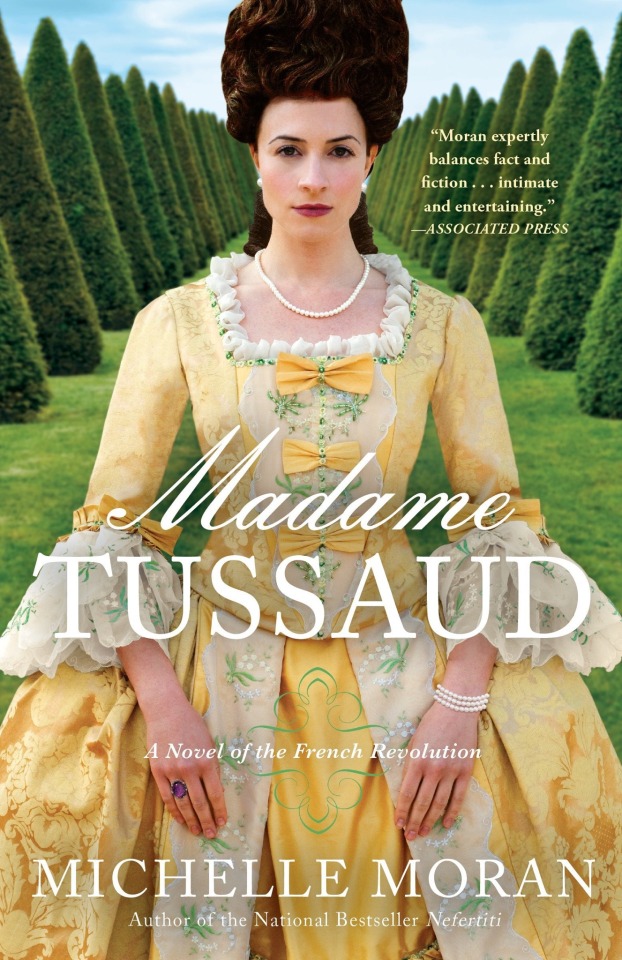
1. The Introduction
This review is dedicated to @maggiec70, @tairin, @pobodleru and @xiranjayzhao .
Greetings, Citizens, and surprise!
Don’t worry, I didn’t call an emergency meeting because the pesky Thermidorians are plotting against us (although we are going to make fun of them because of course we will), but rather because this is a special surprise review I for all you!
Oh, and Happy Easter to those who celebrate it.
Anyway, we’re back at roasting analyzing Michelle Moran’s books. Much like The Second Empress, Madame Tussaud offers a lot to talk about, but while the former book was suggested by @maggiec70 , this one I decided to review on my own accord.
Boy was that a wild ride, but we’ll get to that later. Once again, I managed to find an ebook online because, especially after the rodeo with The Second Empress, I didn’t feel like paying for this shit and it turned out to be a wise decision.
Those who are curious can find the online version here. But for now, let our surprise meeting begin!
2. The Summary
The summary comes from Goodreads and it is rather lengthy, but here we are:
“The world knows Madame Tussaud as a wax artist extraordinaire... but who was this woman who became one of the most famous sculptresses of all time? In these pages, her tumultuous and amazing story comes to life as only Michelle Moran can tell it. The year is 1788, and a revolution is about to begin.
Smart and ambitious, Marie Tussaud has learned the secrets of wax sculpting by working alongside her uncle in their celebrated wax museum, the Salon de Cire. From her popular model of the American ambassador, Thomas Jefferson, to her tableau of the royal family at dinner, Marie's museum provides Parisians with the very latest news on fashion, gossip, and even politics. Her customers hail from every walk of life, yet her greatest dream is to attract the attention of Marie Antoinette and Louis XVI; their stamp of approval on her work could catapult her and her museum to the fame and riches she desires. After months of anticipation, Marie learns that the royal family is willing to come and see their likenesses. When they finally arrive, the king's sister is so impressed that she requests Marie's presence at Versailles as a royal tutor in wax sculpting. It is a request Marie knows she cannot refuse - even if it means time away from her beloved Salon and her increasingly dear friend, Henri Charles.
As Marie gets to know her pupil, Princesse Élisabeth, she also becomes acquainted with the king and queen, who introduce her to the glamorous life at court. From lavish parties with more delicacies than she's ever seen to rooms filled with candles lit only once before being discarded, Marie steps into a world entirely different from her home on the Boulevard du Temple, where people are selling their teeth in order to put food on the table.
Meanwhile, many resent the vast separation between rich and poor. In salons and cafés across Paris, people like Camille Desmoulins, Jean-Paul Marat, and Maximilien Robespierre are lashing out against the monarchy. Soon, there's whispered talk of revolution... Will Marie be able to hold on to both the love of her life and her friendship with the royal family as France approaches civil war? And more important, will she be able to fulfill the demands of powerful revolutionaries who ask that she make the death masks of beheaded aristocrats, some of whom she knows?
Spanning five years, from the budding revolution to the Reign of Terror, Madame Tussaud brings us into the world of an incredible heroine whose talent for wax modeling saved her life and preserved the faces of a vanished kingdom.”
While the summary itself already has traces of propaganda, I think it’s still too early to pass judgment so let’s move on, shall we?
3. The Story
I have to say that the concept of telling the story of a real person, especially a woman like Madame Tussaud, is a cool concept. Someone who isn’t really a Royalist or a Revolutionary, but rather an ordinary businesswoman doing what she can to survive in a turbulent epoch and keep her business afloat.
We already have a shortage of Frev stories about women of the era, after all, let alone ordinary ones like Madame Tussaud who weren’t prominent fighters for a specific cause. Unfortunately, this attempt at telling such a story fails worse than me when I try to play Just Dance. Let me explain.
First of all, the pacing is all over the place. At first (about 10 or so chapters in the beginning) it’s extremely slow, with each chapter taking up about a day. After the events of Frev begin to pick up, however, there are pretty big time skips (several months in between chapters) and the pacing flashes by like a fucking cheetah on a hunt, which is definitely annoying to say the least!
Also, much like The Second Empress, this book takes this infuriating and oversimplified “black vs. white” approach to history. Revolutionaries are all evil (except Desmoulins and Danton), royals are all saints, Frev is bad... you get the idea, Citizens.
There’s no nuance that would allow readers to form their own opinions and all the usual Thermidorian propaganda is almost spoon fed to the audience. It gets so absurd too! For example, at one point doctors show up to check Marie’s virginity because they suspect that she has a lover abroad and could therefore be a spy.
Next, I find it a bit unrealistic that all the future prominent revolutionaries (or at least Camille, Marat and Robespierre) just happen to hang out with Marie (that’s the future Madame Tussaud) and her family and be buddies with them. Maybe I’m wrong, but I just find the setup hard to believe, especially considering the fact that Marat (apparently) didn’t even know Robespierre personally at that point (late 1788) so it’s also inaccurate as fuck.
And, as was the case in The Second Empress, things get quite predictable, even if it’s a given that Marie will survive (her real counterpart did), so it’s not really interesting to watch her story unfold.
But hey, at least we don’t have annoying flashbacks and letters breaking the immersion now! Yay!
4. The Characters
I don’t like Marie herself as a protagonist. Or rather, I don’t like the way she is written here. We do see that she is an ambitious, stubborn businesswoman but it’s not enough to sympathize with her and she is pretty bland otherwise. In fact, due to the opinions she expresses throughout the story, I sometimes get the feeling that she is acting as the author’s avatar/self-insert who is there to regurgitate the author’s bias, because this goes beyond what could be excused as the character being biased.
Henri Charles, Marie’s probably fictional love interest, is also bland so I don’t have much to say about him either.
Madame Élisabeth (the king’s sister) is a pretty pleasant woman but she is portrayed in a “too good for this sinful world” kind of way, as is the rest of the royal family, so she unfortunately lacks even a semblance of complexity that most real people have.
The royal couple is the same way and their flaws are barely touched upon. They’re poor misguided saintly figures ™️ and that’s about it.
Robespierre... whoo boy. This book goes with the classic “he went mad with power and became paranoid” narrative, which is what LRF did. He is portrayed as a dictator who is ready to murder everyone, condones the massacres in Lyon and the elimination of all religion (which is all kind of inaccurate), publicly breaks up with his (implied) lover and humiliates her only to cultivate his image as the Celibate Incorruptible... Oh, and there’s absolutely no mention of the fact that he tried to rescue Madame Élisabeth (yes, the sister of the king).
Marat is treated like a paranoid madman from the beginning and his assasination is implied to be a good thing. Here he is also dirty, disgusting and has no table manners apparently.... Oh and also Marie questions how could Simone be married to him, which gives me unpleasant flashbacks to The Second Empress (the way that shit treated Caroline Murat is atrocious), which is never a good thing.
Can’t judge Jefferson or Lafayette’s cameos, but they’re heroic here, especially Lafayette... By the way, Moran is from the USA, so that probably explains a lot!
Camille and Lucile are heroes and Camille’s siding with Danton is framed as them taking a brave stance against Robespierre. Ugh...
Danton is, predictably, also a hero.
Okay, let’s move on before my sanity leaves the chat.
5. The Setting
Versailles is described with at least surface level accuracy but otherwise the author tries to drive home the point that Paris during Frev was Hell.
Unfortunately, there’s not enough descriptions of places other than the palaces, which really doesn’t help my already nonexistent immersion. At all.
6. The Writing
Oh god, the annoying first person present tense again! Here it makes even less sense than in The Second Empress because the prologue takes place AFTER the main story, yet present tense gives the impression that the main character just narrates everything she is doing in real time, which... *broken computer noises*
Also, some of the French terms aren’t translated which made me scroll through google.
Next, there’s the same “Mistress of the Robes” mistake as in The Second Empress! For those in the back, that position existed in the British court but not the French one! The French have Dame d’Honneur as the equivalent position.
Oh, and also the word “lesbian” is used once in its modern meaning, which apparently wouldn’t be a thing until the 20th century, so there are also (possible) anachronisms.
And there’s at least one incorrect date, like Marat beginning to publish his newspaper on September 7th, 1789 and calling it L’Ami du Peuple (The Friend of the People) right off the bat. But in reality he began to publish his newspaper on September 12th and at first it was called Le Publiciste Parisien (Thé Parisian Publicist) before being renamed several days later.
I know some people might think these anachronisms are no big deal, but they actually are because they demonstrate the author’s attitude to research and the audience. And if these things are an afterthought, then what else did Moran get wrong in possible hopes her audience will just eat up anything she spouts without question?
Readers aren’t idiots and researching even what seems like small details is extremely important as it’s on the author to stay as close to the truth as possible since audiences tend to believe those authors! And this is what concerns me the most: the fact that there are people who will believe Moran and form inaccurate opinions based on Thermidorian propaganda.
*sigh*
But I guess, c’est la vie...
7. The Conclusion
Alright, Citizens, as you may have guessed, I would never recommend this book.
The pacing is inconsistent, the characters are mostly one note like we’re in a damn cartoon, the inaccuracies are through the roof and it’s basically the rehashing of the same propaganda the Frev community is trying to debunk.
But, with this review out of the way, let’s conclude the 26th meeting of the Jacobin Fiction Convention. Happy Easter to those who celebrate it, Citizens!
Oh, and please stay tuned for updates. They’re coming soon.
Love,
- Citizen Green Pixel
#frev#french revolution#history#frev art#maximilien robespierre#jacobin fiction convention#frev literature#michelle moran#madame tussaud 2011#camille desmoulins#georges danton#lucile desmoulins#jean paul marat#marie tussaud#madame elisabeth#marie antoinette#louis xvi#marquis de lafayette#jefferson
58 notes
·
View notes
Photo

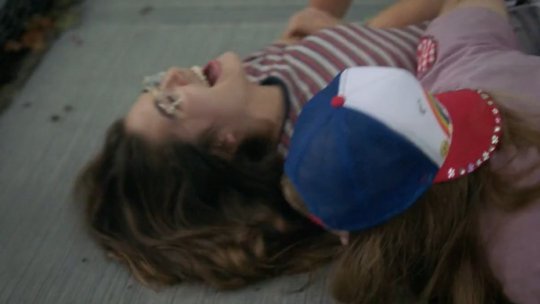
55 notes
·
View notes
Photo





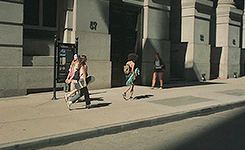


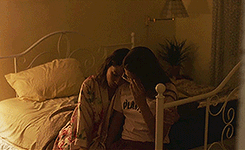

Skate Kitchen (2018) dir. Crystal Moselle
#skate kitchen#rachelle vinberg#nina#nina moran#dede lovelace#moonbear#betty#crystal moselle#women directors#woman director#wlw#skateborading#skate#nyc#new york#2018#movies#2018 movie#camille#jaden smith#betty hbo#gif set#mine
153 notes
·
View notes
Text
rejoice! the glbt historical society has a digital archive collecting the writing of camille moran, a transgender activist for psychiatric survivor rights who advocated for the removal of gender identity disorder from the dsm
you may be familiar with moran from her statement in the fall '93 issue of ex-patient newsletter dendron, "why a transgendered woman calls for psychiatry's destruction". (if not, it can be accessed here, on page 17.) her writing on the psychiatric abuse she experienced as a transgender woman is crucial reading for anyone interested in the psychiatric survivors movement or anti-psychiatric perspectives.
#it speaks!#paths outside this garden#hysterical studies#<- not identifying her as such; this is part of organization for a larger thesis#trans history#psychiatric survivors movement#mad pride#antipsych#i think those are all the main tags that are likely to reach those interested?#camille moran
26 notes
·
View notes
Conversation
Jackie: You need to socialise more when you’re home.
Rose: You never socialise!
Jackie: Bollocks, I’ve done my stint. How do you think I ended up with you? I didn’t parthenogenetically reproduce, Rose, I’m not a frickin’ aphid.
[from Raised By Wolves]
#my post#doctor who#incorrect doctor who quotes#rose tyler#billie piper#jackie tyler#camille coduri#source: raised by wolves#caitlan moran#rebekah staton#raised by wolves#channel 4 raised by wolves
10 notes
·
View notes
Note
It never hurts to be cautious re:prepper thing. I'm sorry the situation is getting worse for you and other trans people in UK. You ARE a natural occurrence in a singing world, yes, what a beautiful way to put it! And it captures the inevitability of it all, I think - it's impossible to get rid of every trans person ever. No matter how hard they try.
And while some things set back the situation by a lot, one shouldn't lose hope! Progress isn't always linear either - I think of the way my own country treated homosexuals only 5 years ago compared to now - it feels like a lifetime, and a different country altogether. Take courage, love, things will get better eventually! - HWA
oh, heart, i don’t know. you’re right, of course, they can never kill us all. we’re like the earth, there’s no getting around us. but what i fear is that it’s impossible for society to truly be comfortable with us. part of me worries we’ll always be looked on with perverse disgust at best, and at worst, people will continue to talk with the same violence in their voices as they do now. i’ve seen it— seemingly regular people wishing death on others as if being trans makes someone a social insect to be crushed. we find ourselves depicted as groomers, as mutilating ourselves, we have surgeries, hormones and identification denied to us, we’re made into suicide jokes, we’re cast as a sexual threat to ‘think of the children’ moral purity…. and we get beaten and murdered. i don’t know. i do still believe in the kindness of the human animal, and that the words of a government do not dictate a man’s real everyday behaviour— but i’ve also seen how the empathy of that animal can stop when it comes to those like me, at least when the actual trans label is mentioned. it’s hard not to think something dark is coming when everything seems to be in place for it. i know you’re right, and that i’m being maudlin, but it’s the topic i can’t help but be maudlin about. i do hope it gets better, and progress is gradual, but i can’t help but get a little “and alien tears shall fill for him / pity’s long-broken urn / and his mourners shall be outcast men, and outcasts always mourn” about it. the man who wrote that couldn’t predict progress any better than we can, but in the end it still took them a century to pardon him
#answered#thank you heart— i know you’re right and i know that other places and people have it much worse than myself#and the natural occurrence thing is camille moran’s words not my own#herb wine anon
1 note
·
View note
Audio
going down in memooooooriiiiies rn
#bob morane contre tout chacal#l'aventurier contre tout guerrier#the instru on this song on of my forever favs#I'm wondering if Camille ever made harry listen to French music
0 notes
Note
Do witches have passives? Like for example would a Severin witch be able to withstand more blood loss because they have blood magic? Or would one of those water witch families (forgot the name, something with an m? I think?? shark familiars???) be able to swim faster or idk, hold their breath underwater for longer? Or a Leroux would automatically know exactly how to best take care of a plant and make it grow without using their powers? Is that a thing or do they have to actively use their magic?
This ties in with another ask that I haven’t answered yet cuz ... takes Thoughts lmfao
In the past you’ve said the Dupre family is fireproof, because it’s how they get their familiars, do any of the other families have an immunity to something because of their magic?
Moran family can def hold their breath under water longer (their familiar summoning ceremony involves going to the bottom of the river to a special platform that is down there to summon it)
LeRoux’s passive you see more in Rowena when she is walking on the log (ep 10?) and plants are growing around her feet. Sort to show that she doesnt’ have control of her magic yet and is able to make stuff grow freely.
Severin magic..., probably, You see Camille go through severe blood loss in a way that most people would probably be way too woozy to really handle LMAO speaking from experience as someone with anemia that stuff fucks you up quick LOL
42 notes
·
View notes
Text

Julie Mehretu, Untitled 2, 1999. Private collection. Courtesy of White Cube. © Julie Mehretu

Julie Mehretu, Hineni (E. 3:4), 2018. Centre Pompidou, Paris, Musée national d’art moderne/Centre de création industrielle; gift of George Economou, 2019. © Julie Mehretu. Photography:Tom Powel Imaging
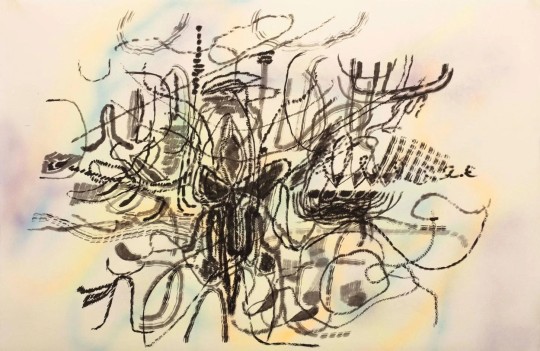
Julie Mehretu, Mind-Wind Field Drawings (quarantine studio, d.h.) #1, 2019-2020. Private collection, courtesy Marian Goodman Gallery New York/Paris. © Julie Mehretu. Photography courtesy Marian Goodman Gallery

Julie Mehretu, Mogamma (A Painting in Four Parts) Part 1, 2012. Guggenheim Abu Dhabi. © Julie Mehretu. Photography: White Cube, Ben Westoby

Julie Mehretu, Conjured Parts (eye), Ferguson, 2016. The Broad Art Foundation, Los Angeles. © Julie Mehretu. Photography: Cathy Carver

Julie Mehretu, Migration Direction Map (large), 1996. Private collection. © Julie Mehretu. Photography: Tom Powel Imaging
At home with artist Julie Mehretu
CAMILLE OKHIO - 25 MAR 2021
Julie Mehretu speaks with the joy and conviction of someone who has had the freedom to investigate all their interests. Curiosity has led her to the myriad topics, objects and moments that inform her work, among them cartography, archaeology, the birth of civilisation and mycology. Since the 1990s, her practice has expanded outwardly in all directions like a spider web. A lack of understanding and preconceived notions among reviewers have often led to her work being flattened – simplified so that it is easily digestible – but in reality, her work is far from a simplistic investigation of any one topic. It encompasses multitudes.
The artist’s recent paintings are mostly large scale, but her early works on paper (often created with multiple layers – one sheet of Mylar on top of another) are as small as a six-inch square. The works often comprise innumerable minuscule markings – tremendous force and knowledge communicated through delicate inkings and streaks. Their layers reveal, rather than obfuscate. And though Mehretu’s creative process springs from a desire to understand herself better, the work itself is in no way autobiographical.
Born in Addis Ababa, Ethiopia, on the tails of a continental rejection of colonialism, and raised there, then in Michigan, Mehretu has a flexible and full-hearted understanding of home. It is not one physical place, but many, all holding equal importance. On 25 March, Mehretu will present her first major retrospective at the Whitney Museum of American Art, with works spanning 1996 to 2019. The institution is an important one for Mehretu, as it played host to several pivotal shows in her youth.
Her exhibition has served as an impetus for Mehretu to look back at her already prolific career, observing and organising the thoughts, questions and answers she has put forth for over two decades. The six years it took to bring this exhibition together proved an incredibly valuable time of reflection, fatefully dovetailing with a year of quarantine.
Wallpaper*: Where are you as we speak?
Julie Mehretu: I’m in my studio on 26th Street, right on the West Side Highway. I’ve worked here for 11 years.
W*: Are there any artists, writers or thinkers that have had a meaningful impact on you?
JM: I don’t know how to answer that because there are literally so many! It’s constantly changing. Right now, Kara Walker, David Hammons, William Pope.L, and younger artists like Jason Moran (who has made amazing work around abstraction). There are so many artists that have been informative and important to me: Frank Bowling, Jack Whitten, Caravaggio.
I also look at a lot of prehistoric work, from as far back as 60,000 years ago, as well as cave paintings from 6th century China and early prehistoric drawings in the caves of Australia.
W*: What’s the most interesting thing you have read, watched or listened to recently?
JM: For the last few weeks I’ve been immersed in Steve McQueen films. I’ve been bingeing on lovers rock music. And a TV show that really moved me was [Michaela Cole’s] I May Destroy You. It’s difficult, but it was really well done and powerful.
Ocean Vuong’s novel On Earth We Are Briefly Gorgeous is amazing. The Mushroom at the End of the World by Anna Lowenhaupt Tsing is a really incredible book too – she studies this mushroom that became a delicacy in Japan in the 7th century. It started growing in deforested areas – it’s in these places destroyed by human beings that these mushrooms survive. [I find it interesting] that this mushroom grows on the edge of precarity and destruction. Like with Black folks, there is a constant aspect of insisting on yourself and reinventing yourself in the midst of constant effort of destruction.
W*: What was the first piece of art you remember seeing? How did you feel about it?
JM: One of the first times I remember being moved by a work of art was looking through my mother’s Rembrandt book. We brought so few things back from Ethiopia and that was one of them. [Particularly] Rembrandt’s The Sacrifice of Isaac. That story is so intense. I was so moved by the light and the skin and the way the paint made light and skin.
W*: Do you travel? If so, what does travel afford you, and what have you missed about it during Covid-19?
JM: I travel a lot, but I haven’t travelled this year. There has been this amazing sense of suspension and a pause in that. I miss travelling, but going to look at art, watching films, reading novels and listening to music is the way I travel now. For instance, I’ve been listening to Afro-Peruvian music and now I want to go to Peru.
Before I know it we will be back in this fast-paced, zooming-around environment – there is something I want to savour by staying here, now, in this time and absorbing as much as I can.
W*: You are said to have a vast collection of objects and images. Walk me through your collection – what areas, materials, makers and things have the largest presence and why?
JM: When you enter our home there is this long hallway. Framed along the wall we have around 20 fluorescent Daniel Joseph Martinez block-printed posters he made with words – almost poems. Our kids grew up reading those. One says ‘Sometimes I can’t breathe’ and another one says ‘Don’t work’, while some are really long.
We also have a great Paul Pfeiffer photograph of one from the Four Horsemen of the Apocalypse series. We have a group of Richard Tuttle etchings right over our dining table. We have an amazing David Hammons body print as well, and my kids’ work is all over the house.
W*: As the daughter of immigrants and an immigrant yourself – how do you conceptualise home and how do you create it?
JM: There were a lot of times I felt very transient – as a student and a young adult, going in and out of school and residency programmes. It always came back to music and food. There are certain flavours, foods, music, smells that you take wherever you go. Also as a mother, I’m building a home for my children. Home becomes something else because of them. They are the core of home now.
W* How has motherhood affected your practice?
JM: I became much more productive when I had kids for several reasons – one is that I felt a lot of pressure to make [work] in the time I wasn’t with them, which of course is unsustainable. A large part of making is not making – thinking and searching.
When I got to work I could get into it much more quickly. Kids grow and change so fast, you feel time is passing so you need to use it. I wasn’t going to stop working, that’s for sure. All women who are pushing in their lives make that choice.
W*: What is your favourite myth and why does it hold importance for you?
JM: Right now I’m reading Greek myths to my ten-year-old. We’ve read them before, but he wanted to read them again. I still read to him at night even though he’s a voracious reader himself.
The myths I remember the most are myths I’ve come across in visual works. Titian’s Diana and Actaeon – I know that myth so well because of his painting. Bernini’s mesmerising sculpture of Apollo and Daphne I saw in Rome, where her body becomes a tree. The leaves are so delicately carved into the marble, it’s a work of incredible beauty. I’ve been considering this deconstructionist approach to mythology. Storytelling becomes this place to interrogate propositions, which is what I think mythology does.
W*: Have you experienced a flattening of your work?
JM: I’m always concerned with flattening and pigeonholing. That is something that happens to artists like us all the time. When I first was working and showing there was a bit of that happening with my work. It was put into the space of cartography or an architectural analysis of it. It was said to be autobiographical work.
The art world tries to consume. There is this desire to flatten and the desire for Black artists to be a reflection of their experience. I don’t think any artist is like that at all. In reality, none of us are flat. We all contain multitudes and are complicated – that has always been the core of the Black radical tradition.
34 notes
·
View notes
Photo

Mercredi 19 mai 2021 à 19H, nouvelle émission de la Petite Boutique Fantasque ayant comme titre : Aussi épaisses que soient les brumes qui protègent le paysage. Cette émission propose une lecture de la nouvelle de Léon Bloy, Terrible châtiment d'un dentiste, tirée des Nouvelles désobligeantes Elle a été réalisée Protools pour la lecture de Juliette et sur Garageband pour le montage. Diffusion en hertzien, Toulouse : 106.8 Mhz ou en streaming https://www.radioradiotoulouse.net/ et pour tout le reste du temps sur les podcasts de mixcloud.
Programmation musicale :
1) Mes sabots de bois (Anne Sylvestre)
2) Prélude de l'enfant noir (Jean-Louis Florentz)
3) Si j'avos su, j'avos resté garchon (Raoul de Godewarsvelde)
3) CNN predicts a monster storm (Laurie Anderson / Chronos quartet)
4) Go down Moses (Archie Shepp / Jason Moran)
5) Ode 1 (Les Grandes gueules / Raymond Queneau)
6) Pauvre Camille (Gribouille)
7) No one seem to know (Neil Young)
+ Lecture de Juliette des remords d'un dentiste par Léon Bloy
Pour ceux qui auraient piscine indienne, ou toute autre obligation, il y a une possibilité de rattrapage avec les podcasts de la PBF : https://www.mixcloud.com/RadioRadioToulouse/aussi-épaisses-que-soient-les-brumes-la-petite-boutique-fantasque/
Allons-y gaiement et sans mollir !
2 notes
·
View notes